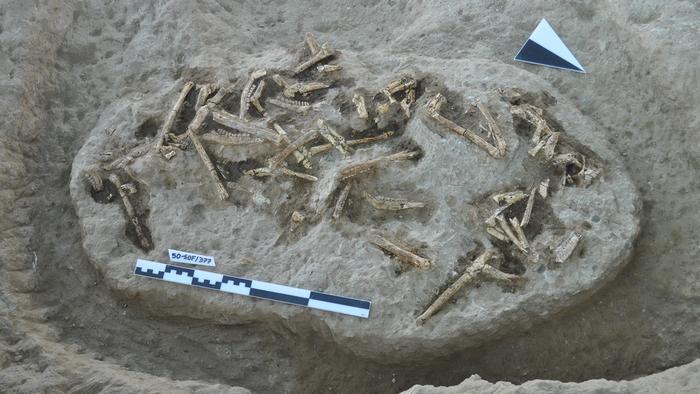An international research team, co-led by the University of Oulu, has made significant strides in the field of paleobiology with their recent findings in Central Anatolia, Türkiye. Utilizing a cutting-edge Argon-Argon (⁴⁰Ar/³⁹Ar) radioisotopic dating method, the researchers have successfully dated fossil-rich sites in the region, estimating their origins to be between 7 and 10 million years ago. This breakthrough has not only provided a clearer timeline of ancient fauna but has also repositioned Türkiye as a critical geographical nexus for studying mammalian evolution during the Miocene epoch.
The intricacies of dating fossils often come with numerous challenges, particularly when the surrounding sedimentary layers lack suitable volcanic material for radiometric dating. Many historically significant fossil sites, especially those rich in vertebrate remains, are often located in sediments that are difficult to date accurately. Nonetheless, Central Anatolia serves as a geological marvel, resting on the outskirts of active volcanic centers where layers of rare, fossil-bearing strata have been preserved alongside volcanic ash deposits. This combination has granted researchers a unique opportunity to access high-precision dates for the fossil records.
Ferhat Kaya, an Academy Research Fellow from the University of Oulu and one of the project’s co-leads, noted that the dating fossil faunas has traditionally relied on identifying associations with geographically distant faunal assemblages. These proxies often presented poorly constrained correlations between Europe and Asia that obscured the accurate timelines of evolution. With this innovative approach utilizing Argon-Argon dating, scientists are now capable of pinpointing the geological age of the fossil layers more effectively, shedding light on a timeline that has implications for understanding evolutionary trajectories stretching back over a million years.
The fossil discoveries themselves are noteworthy, featuring skeletal elements of herbivorous mammals that exhibit traits reminiscent of modern antelopes and horses. These discoveries include lower jaws and limb bones, which play a vital role in reconstructing the ecological dynamics of past environments. The significance of these fossils is compounded by their context within reworked volcanic sediment, which enhances both their preservation and the potential insights they can provide into species adaptation amid fluctuating climate conditions.
Kaya explained that the precision in dating these mammalian fossils opens up an array of opportunities for researchers to better understand primate evolution. The refined ages allow for more accurate examinations of the historical ecological shifts prompt alterations in species characteristics and diversifications. This precision is particularly crucial for deciphering the lineage of mammals, including the large Miocene apes such as the genus Ouranopithecus, posited to be an ancestor of both contemporary African apes and early human-like bipedal species.
The sophisticated nature of this research is rooted not only in sophisticated radiometric techniques but also in the burgeoning fields of digital fossil databases and computational meta-analyses. While advancements in technology have provided extensive data at researchers’ fingertips, it is critical to note that reliance on large databases must meet rigorous standards of accuracy and consistency to ensure meaningful conclusions. Kaya’s team emphasizes that alongside accurate geological dating, detailed and precise identifications of fossil species are essential for advancing the field substantially.
As scholars pick through the findings, they confront a pivotal question: how did these marrow-rich herbivores adapt to their environments, and what environmental changes precipitated their evolution? By examining the timeline laid out through this new research, scientists can potentially correlate environmental upheavals—ringing through both local habitats and intercontinental influences—with natural selection pressures that drove the evolution of these mammals.
Moreover, Central Anatolia’s geological wealth, punctuated by its proximity to volcanic activity, enables researchers to pursue high-precision dating more comfortably than many other sedimentary sites. The volcanic deposits in which these fossils are embedded are characterized by glassy grains that provide an optimal medium for radiometric dating. This intrinsic relationship between geological features and fossil preservation underscores the exceptional value of this research site in delivering a clearer understanding of mammalian history over millions of years.
The impact of the findings resonates across paleontological disciplines, reinforcing Türkiye’s burgeoning role as a central hub for fossil studies. As the home of sites where ancient ecosystems intersect, the region offers an unparalleled venue for ongoing research into mammalian evolution that connects Africa, Asia, and Europe. With these rich deposits of knowledge, researchers are poised to make profound contributions that will shape our understanding of life on Earth through geological epochs.
The current study, titled "Building better biochronology: New fossils and ⁴⁰Ar/³⁹Ar radioisotopic dates from Central Anatolia," is scheduled for publication in the prestigious journal Proceedings of the National Academy of Sciences of the United States of America (PNAS) and is part of the Cappadocia Paleontological Expeditions project. This exciting research promises to enrich scientific conversations around mammalian evolution, offering improved chronological frameworks that enhance our grasp of how ancient life forms adapted and thrived.
As research continues and new discoveries unfold, the collaboration between geological sciences and paleobiology is fortified. Researchers are not only improving methodologies for dating fossils but are simultaneously redefining the narrative of mammalian evolution and environmental change. Ferhat Kaya highlights that these advancements are critical for understanding the mosaic of evolutionary history, ensuring that future investigations into Central Anatolia’s fossil wealth remain pivotal for the scientific community.
The echoes of this research will resonate far beyond the fossil layers of Türkiye, hinting at the broader implications for global paleontological studies and offering fresh insights into the complex dance of evolution across ecosystems both ancient and modern. With each layer unearthed, scientists move closer to piecing together the vast puzzle of life on Earth.
Subject of Research: The dating of fossil sites in Central Anatolia, Türkiye, using Argon-Argon radioisotopic methods.
Article Title: Building better biochronology: New fossils and 40Ar/39Ar radioisotopic dates from Central Anatolia
News Publication Date: 17-Mar-2025
Web References: Proceedings of the National Academy of Sciences
References: Article reference link as provided.
Image Credits: Photo: Ferhat Kaya.
Keywords: Fossil dating, Central Anatolia, Argon-Argon dating, mammalian evolution, paleontology, volcanic ash, Ouranopithecus.




